What are the top priorities and challenges related to the use of cloud computing? The Flexera 2025 State of the Cloud Report draws on the insights of 759 cloud decision-makers and users globally who took part in a survey in late 2024. The results illustrate the evolution of ongoing trends in past years, while simultaneously spotlighting the emergence of new forces driving cloud usage.
Workloads move back to data centers
A noteworthy shift of applications and data back from cloud to data centers—known as repatriation—is happening. Slightly more than one-fifth (21%) of workloads and data have been repatriated. However, ongoing migration to cloud and net-new cloud workloads outstrip these cloud exits, resulting in continued cloud growth.
Analysts and experts have, for some years now, indicated that organizations are moving cloud workloads back to their own data centers, often due to the inefficiencies and expenses that result from failing to refactor applications for cloud. Although net-new cloud workloads are still increasing, the frequency of repatriation is notable.
Sustainability gains ground
Cloud sustainability initiatives are becoming top of mind for many respondents. More than half (57%) of respondents either have or plan to have a defined sustainability initiative that includes carbon footprint tracking of cloud use within the next 12 months. With more than a third (36%) of all respondents already tracking their cloud carbon footprint, the need to do so has clearly been gaining traction.
Among European respondents, the number tracking their cloud carbon footprint rises to 43%. The gap between European respondents and respondents overall is closing; as an increasing number of global organizations adopt and adhere to important sustainability standards, this gap is expected to shrink even further.
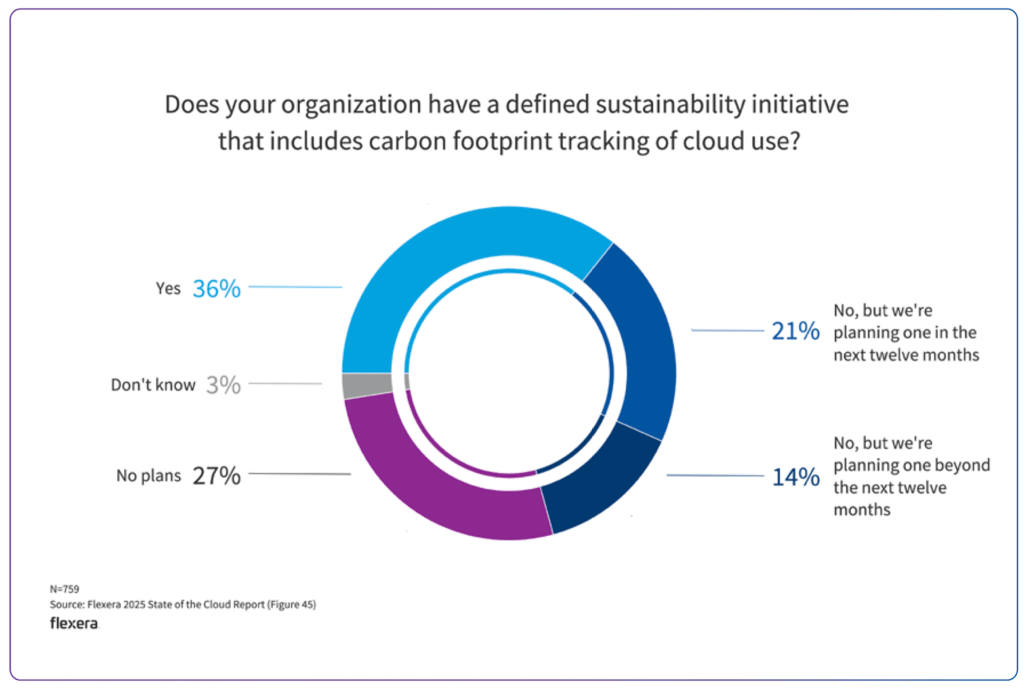
Flexera
Generative AI is becoming mainstream
Not a surprise: Adoption of AI-related public cloud services is exploding. Almost half of respondents indicate that their organizations already use artificial intelligence/machine learning (AI/ML) platform-as-a-service (PaaS) services. This year’s survey also shows a surge in the use of data warehouse services, which are often used to feed AI models.
Generative AI use is also booming. Nearly three-quarters (72%) of organizations already use genAI either sparingly or extensively; another 26% are currently experimenting with genAI. Not only is genAI here to stay, but it’s becoming mainstream.
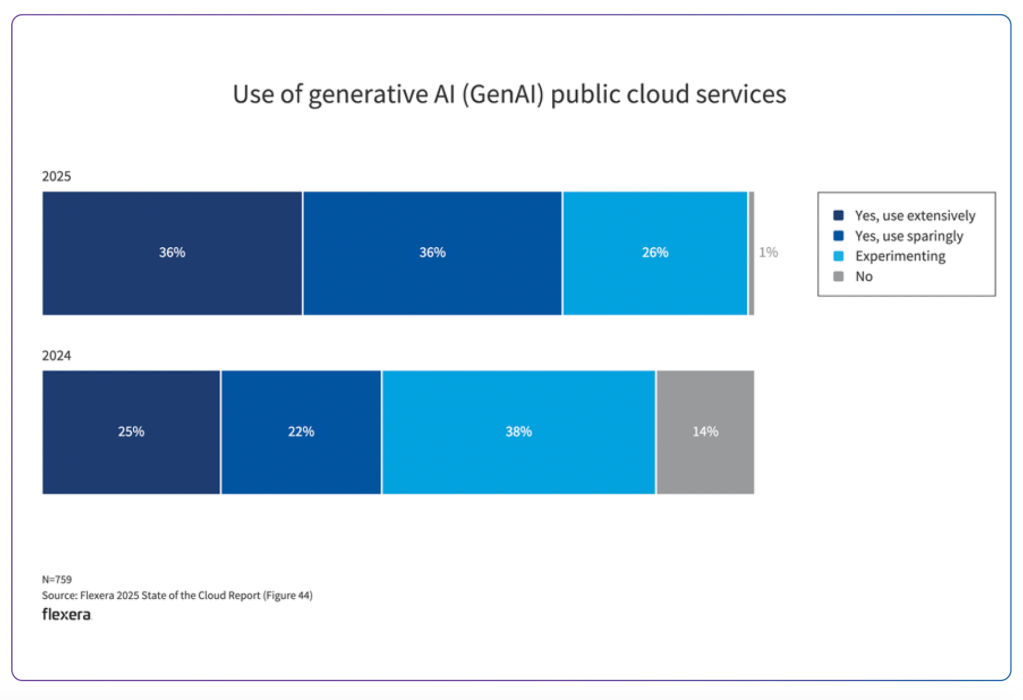
Flexera
Cloud spend and security are the top challenges
Managing cloud spend is the top cloud challenge for organizations of all sizes, reported by 84% of respondents. As additional workloads find their way into the cloud, the need to manage and optimize the associated spend becomes paramount. Nearly nine out of 10 (87%) identify “cost efficiency/savings” as their top metric for assessing progress against cloud costs, making it the leading metric in this category, jumping from 65% a year ago. Similarly, “cost avoidance,” which can be achieved with proper license management, rose from 28% to 64% during the same period. As software-as-a-service (SaaS) usage increases, the focus on SaaS licensing is gaining increased attention, given the significant impact that SaaS expenses have on driving up cloud bills.
Following cloud spend as the top cloud challenge is security. Reported by 77%, security—always a top concern in the digital age—is the second-largest challenge for cloud initiatives. Among the tools used for managing multi-cloud initiatives, security tools take the number-one spot, with 55% of all respondents using them.
Public cloud adoption continues to accelerate
Public cloud spend continues to increase, with a third (33%) spending more than $12 million a year, up from 29% of respondents last year. Among enterprises (with more than 1,000 employees), the number spending this amount goes up to 40%. Even as cloud costs rise, more workloads are finding a home in the cloud. SaaS expenses remained fairly consistent year over year.
An area of hesitance is around sensitive data. Organizations remain cautious about moving sensitive data to the cloud, although more than a third indicate that all non-sensitive data will move to the cloud.
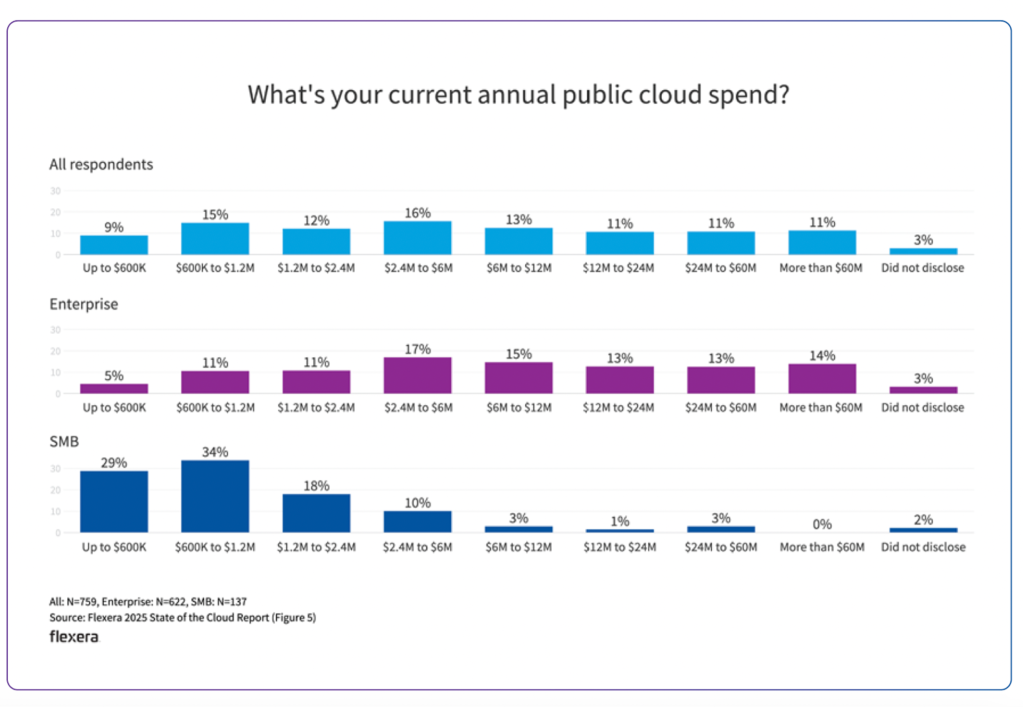
Flexera
Centralized initiatives grow
The approach to governing and optimizing cloud and SaaS costs is shifting from vendor management teams towards cloud centers of excellence (CCOEs) and FinOps teams, representing a centralized approach to cloud. Today 69% of respondents have a CCOE or central cloud team.
Additionally, cloud cost optimization strategies are increasingly being handled by FinOps teams. Nearly three-fifths (59%) of respondents now indicate that they have a FinOps team for some or all of their cloud cost optimization strategies, up from 51% a year ago. As FinOps gains additional traction within the cloud community, particularly with SaaS and data centers now part of the FinOps scopes, reliance on FinOps teams across organizations is anticipated to rise.
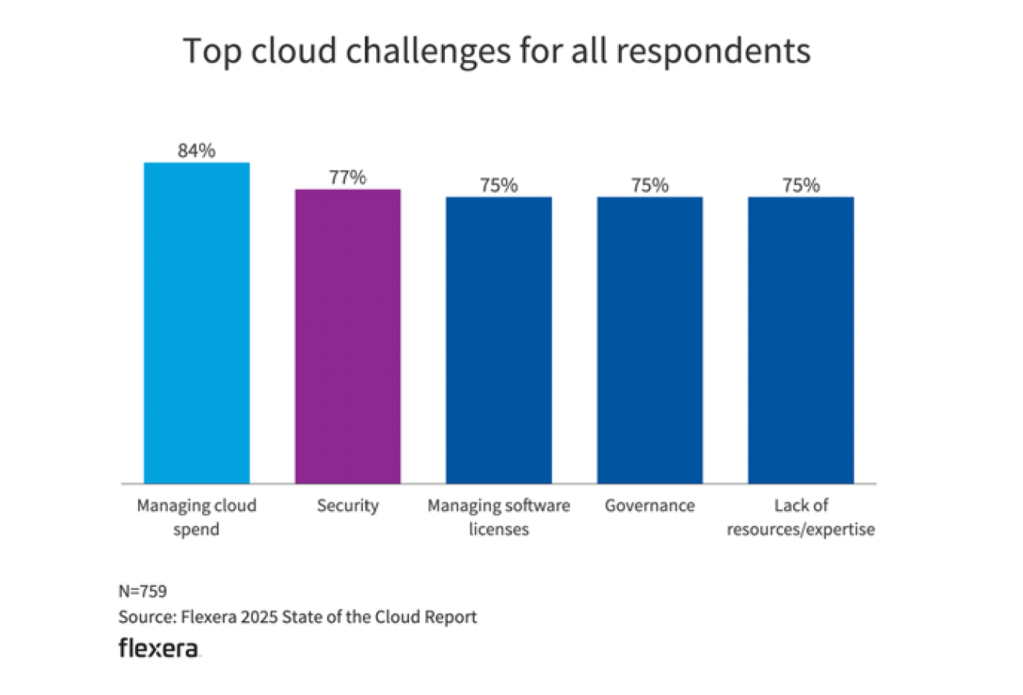
Flexera
AWS and Azure compete for dominance
Year over year, this ongoing research shows that there has been little change among the leaders, with many organizations seemingly having found their steady state regarding the cloud—or mix of clouds—they’re using. Among all respondents, it boils down to a race that continues between Amazon Web Services (AWS) and Microsoft Azure as leading public cloud providers. A close contest in recent years, the two providers trade leads, based on the number of workloads running.
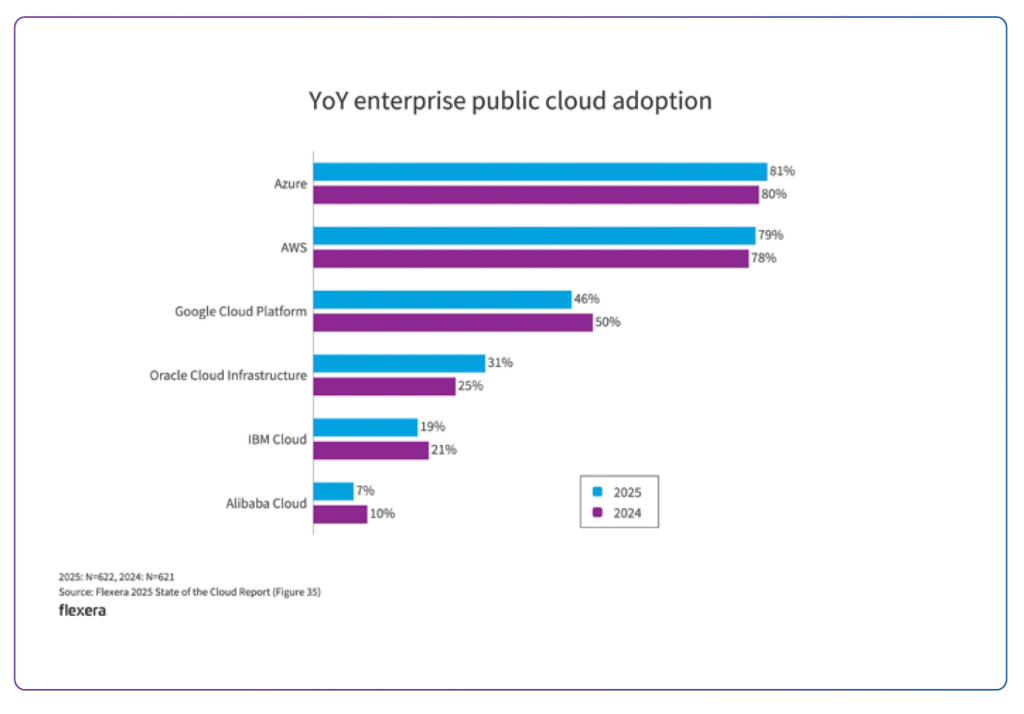
Flexera
Historically, enterprises are more likely to utilize Azure than are small- to medium-sized businesses (SMBs, with fewer than 1,000 employees). Today, among enterprises, AWS holds a slight lead (53%) over Azure (50%) among organizations that run “significant workloads,” while Azure (81%) has the lead over AWS (79%) when also including “some workloads.”
As part of cloud strategy, organizations continue to embrace multi-cloud: 70% of respondents embrace hybrid cloud strategies, using at least one public and one private cloud, while the remaining 30% use only public clouds or private clouds. Large enterprises (with more than 10,000 employees) make use of multi-cloud tools more than smaller organizations, regardless of the tool type.
Looking ahead
Growing cloud usage, initiatives to optimize costs, competition between the top cloud providers, and the ongoing use of AI all promise to be hallmarks of cloud programs in 2025. The new emphases on repatriation and sustainability will modulate how cloud initiatives are managed.
Brian Adler is senior director of cloud market strategy at Flexera. He was previously a senior director analyst at Gartner and a member of the FinOps Foundation governing board.
—
New Tech Forum provides a venue for technology leaders—including vendors and other outside contributors—to explore and discuss emerging enterprise technology in unprecedented depth and breadth. The selection is subjective, based on our pick of the technologies we believe to be important and of greatest interest to InfoWorld readers. InfoWorld does not accept marketing collateral for publication and reserves the right to edit all contributed content. Send all inquiries to doug_dineley@foundryco.com.
What are the top priorities and challenges related to the
use of cloud computing? The Flexera 2025
State of the Cloud Report draws on the insights of 759 cloud
decision-makers and users globally who took part in a survey in late 2024. The
results illustrate the evolution of ongoing trends in past years, while
simultaneously spotlighting the emergence of new forces driving cloud usage. Repatriation highlights the move back to data centersA noteworthy shift of applications and data back from
cloud to data centers— known as repatriation—is happening. Slightly more than
one-fifth (21%) of workloads and data have been repatriated. However, ongoing migration to cloud and net-new cloud workloads
outstrip these cloud exits, resulting in continued cloud growth. Analysts and experts have, for some years now, indicated
that organizations are moving cloud workloads back to their own data centers,
often due to the inefficiencies and expenses that result from failing to
refactor applications for cloud. Although net-new cloud workloads are still
increasing, the frequency of repatriation is notable. Sustainability
gains groundCloud sustainability
initiatives are becoming top of mind for many respondents. More than
half (57%) of respondents either have or plan to have a defined sustainability initiative
that includes carbon footprint tracking of cloud use within the next 12 months.
With more than a third (36%) of all respondents already tracking their cloud
carbon footprint, the need to do so has clearly been gaining traction. Among European
respondents, the number tracking their cloud carbon footprint rises to 43%. The
gap between European respondents and respondents overall is closing; as an
increasing number of global organizations adopt and adhere to important sustainability
standards, this gap is expected to shrink even further.
Ongoing trends continueIn
addition to the above standouts revealed in this year’s research, ongoing
trends continue to evolve in ways that impact day-to-day business management
for the organizations using cloud. Generative AI
is becoming mainstream:Not a surprise: adoption of AI-related public cloud services is
exploding. Almost half of respondents indicate that their organizations already
use artificial intelligence/machine learning (AI/ML) platform-as-a-service (PaaS)
services. This year’s survey also shows a surge in the use of data warehouse
services, which are often used to feed AI models. Generative AI (Gen AI) use is also booming. Nearly three-quarters (72%)
of organizations already use GenAI either sparingly or extensively; another 26%
are currently experiment with GenAI. Not only is GenAI here to stay, but it’s
becoming mainstream, at least in some capacities.
Cloud spend & security are the top challenges:Managing
cloud spend is the top cloud challenge for organizations of all sizes, reported
by 84% of respondents. As additional workloads find their way into the cloud,
the need to manage and optimize the associated spend becomes paramount. Nearly
9/10 (87%) identify “cost efficiency/savings” as their top metric for assessing
progress against cloud costs, making it the leading metric in this category,
jumping from 65% a year ago. Similarly, “cost avoidance,” which can be achieved
with proper license management, rose from 28% to 64% during the same period. As
software-as-a-service (SaaS) usage increases, the focus on SaaS licensing is
gaining increased attention, given the significant impact that SaaS expenses
have on driving up cloud bills. Following cloud spend as
the top cloud challenge is security. Reported by 77%, security—always a top
concern in the digital age—is the second-largest challenge for cloud initiatives.
Among the tools used for managing multi-cloud initiatives, security tools take
the #1 spot, with 55% of all respondents using them. Public cloud
adoption continues to accelerate: Public cloud spend is increasing, with a third (33%) spending more than
$12 million a year, up from 29% of respondents last year. Among enterprises (with
more than 1,000 employees), the number spending this amount goes up to 40%. As
cloud costs rise, more workloads are moving to or born in the cloud. SaaS
expenses remained fairly consistent year over year. An
area of reticence is around sensitive data. Organizations remain cautious about
moving sensitive data to the cloud, although more than a third indicate that
all non-sensitive data will move to the cloud.
Centralized
initiatives grow:The approach to governing and optimizing cloud and SaaS costs is
shifting from vendor management
teams towards cloud centers of excellence (CCOEs) and FinOps teams,
representing a centralized approach to cloud. Today 69% of respondents have a
CCOE or central cloud team. Additionally, cloud cost
optimization strategies, in particular, are increasingly being handled by
FinOps teams. Nearly three-fifths (59%) of respondents now indicate that they
have a FinOps team for some or all of their cloud cost optimization strategies,
up from 51% a year ago. As FinOps gains additional traction within the cloud
community, particularly with public cloud and SaaS now part of the
FinOps Scopes, reliance on FinOps teams across organizations is
also anticipated to rise.
Top vendors compete for dominance: Year over year, this ongoing research shows that
there has been little change among the leaders, with many organizations
seemingly having found their steady state regarding the cloud—or mix of clouds—they’re
using. Among all respondents, it boils down to a race that continues between Amazon Web Services (AWS) and Microsoft Azure
as leading public cloud providers. A close contest in recent years, the two
providers trade leads, based on the number of workloads running.
Historically,
enterprises are more likely to utilize Azure than are small- to medium-sized
businesses (SMBs, with fewer than 1,000 employees). Today, among enterprises, AWS
holds a slight lead (53%) over Azure (50%) among organizations that run
“significant workloads,” while Azure (81%) has the lead over AWS (79%) when
also including “some workloads.” As part of cloud strategy,
organizations continue to embrace multi-cloud: 70% of respondents embrace
hybrid cloud strategies, using at least one public and one private cloud, while
the remaining 30% use only public cloud(s) or private cloud(s). Large
enterprises (with more than 10,000 employees) make use of multi-cloud tools
more than smaller organizations, regardless of the tool type. Looking aheadGrowing cloud usage, initiatives to optimize costs, competition between
the top cloud providers, and the ongoing use of AI all promise to be hallmarks
of cloud programs in 2025. The new emphases on repatriation and sustainability
will modulate how cloud initiatives are managed.
Brian Adler is senior director of cloud market strategy at Flexera
and was previously a senior director analyst at Gartner and a former member of
the FinOps Foundation governing board.
